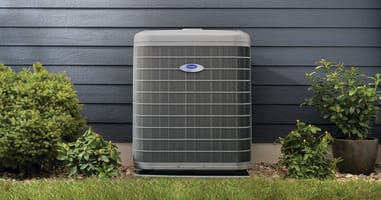What is Central Air Conditioning and How Does Central Air Work?
What is central air conditioning? How does air conditioning work in a central air system? Central air conditioning is a common term used to describe most whole-home air conditioning systems. It replaces warm air with cool air that’s been passed over cold coils, then pushes it into your living spaces. There are two different types of central air conditioners—split systems and packaged systems. A split system has both an indoor and outdoor unit, while a packaged system is contained in a single outdoor unit to help when there is limited space.
How does a central air conditioner work?
- When the indoor temperature rises above your desired set point, the thermostat turns on the system.
- The fan in the indoor unit pulls warm air from inside your home into return air ducts, then passes it through filters to remove dust and airborne pollutants.
- That air passes over the cold evaporator coil, where liquid refrigerant absorbs heat, changes it into a gas refrigerant, and cools the air.
- The blower fan then sends the cooled air into living spaces.
- The now-warm gas refrigerant travels to the compressor through copper tubing.
- The compressor pressurizes the gas and sends it to the condenser coil, which releases the heat outdoors and turns the refrigerant back to liquid.
- The refrigerant travels to the evaporator coil to continue the cycle.

Parts of a Central Air Conditioning System
- Both a split system and a packaged system use a thermostat to control the temperature and ductwork to circulate air around the indoor living spaces
- In a split system:
- Outdoor unit —fan, condenser coil, and compressor
- Indoor unit —furnace or fan coil, which houses the evaporator coil and fan to circulate cool air
- Copper tubing —where the refrigerant flows between the indoor and outdoor units
- In a packaged system:
- Fan, condenser coil, compressor, and fan coil —all in one unit

Learn More on Central Air Conditioning System Topics
Still have questions on what is central air all about? Contact a Carrier HVAC contractor to find out more about air conditioning systems and solutions. They have the knowledge and expertise to get your questions answered.

Frequently Asked Questions About Central Air Conditioning
Learn More About Central Air Conditioning System Topics
- Find a Carrier Air Conditioner Expert in your area
- Air Conditioner Maintenance Tips
- Air conditioner price; How much does it cost?
- Help with Air Conditioner Service
- Find Out How Do Air Conditioners Work
- Learn about air conditioning repair
- Wondering "What Size Air Conditioner Do I Need?"
- Troubleshoot an Air Conditioner tips
- Learn about Air Conditioner Coil Cleaning
- Factors and variables - "How Long Do Air Conditioners Last?"
- Why you should get an AC Tune Up
- Learn about air conditioning installation
- Browse air conditioning systems
- Learn about different HVAC system types



